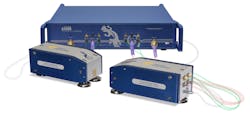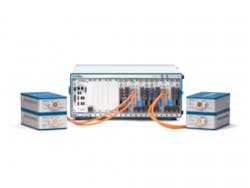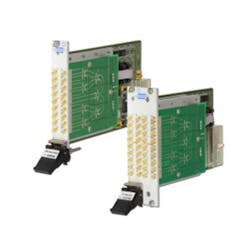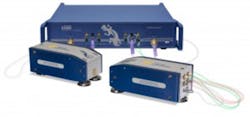IMS 2016 sees chips and instruments targeting mmWave applications
The International Microwave Symposium 2016 took place May 23-26 in San Francisco. Organizers said that 635 companies presented their products and services on the exhibit floor Tuesday through Thursday. Gallium nitride technology and millimeter-wave measurements as applied to 5G and automotive radar applications were hot topics.
And while 5G promises to represent the next generation of cellular technology, Dr. Martin Cooper—the “father of the cellphone”—used his Monday opening keynote address to predict its death, at least in its current form. The cellphone is a blunt instrument, he said. It does almost everything, but doesn’t do anything optimally and will need to evolve. The death of the cellphone may take a generation or two, but when it happens, he concluded, “Remember, Marty told you about it.”
Nevertheless, throughout the rest of the symposium, cellphone and related technologies were alive and well—albeit evolving. At a Tuesday morning press conference, Mark Pierpoint, vice president and general manager, Internet and Infrastructure, Keysight Technologies, suggested what the evolution might look like. He described a bimodal distribution of opportunities—with a division between low-bit-rate, low-duty-cycle applications that can run 20 years on an AA cell and 5G pre-standardization efforts promising better than 10-Gb/s continuous data rates. (See “At IMS 2016, Keysight plans to ride technology waves” for more.)
Keysight also highlighted its long-term relationship with Cascade Microtech, extending from work in 1991 on the HP/Keysight 4155 semiconductor parameter analyzer in conjunction with Cascade Microtech MicroChamber technology. And last year, the companies debuted a turnkey wafer-level measurement solution for fast and accurate semiconductor on-wafer measurements that saves time and reduces customer risk with guaranteed system configuration, installation, and support.
On the show floor, Keysight highlighted a variety of instruments and software, including X-Series signal analyzers, CX3300 Series device current waveform analyzers, and an E-band testbed solution that enables the generation and analysis of wide-bandwidth millimeter-wave signals for 5G and other emerging communications applications.
As for software, Keysight highlighted the EEsof EDA SystemVue 2016 release, which includes a phased-array library and 5G baseband verification library. In addition, the company presented Advanced Design System 2016, Genesys circuit-synthesis software, and EMPro 3D electromagnetic simulation software.
National Instruments highlighted a number of innovations, including advanced millimeter wave technology for channel sounding and 5G prototyping as well as advanced solutions for RFIC test, from lab-based characterization systems to high-volume manufacturing test solutions using the NI STS.
NI also touted advances in NI AWR software design solutions for power amplifier, antenna, filter, and radar system design through new automation and tool interoperability. NI said a new EM Socket II architecture within NI AWR Design Environment has been developed in order to enhance the AWR Connected for EM interoperability between third-party electromagnetic (EM) simulation tools and the company’s flagship high-frequency circuit-design software, Microwave Office. The latest release of an AWR Connected solution is for ANSYS Inc.’s High Frequency Electromagnetic Field Simulation (HFSS) software. In addition, Sonnet Software and Computer Simulation Technology (CST) have upgraded from prior EM Socket implementations to the new format.
In addition, NI highlighted a software defined radio (SDR) for the mmWave spectrum. The new NI mmWave Transceiver System can transmit and receive wide-bandwidth signals at a 2-GHz real-time bandwidth, covering the spectrum in the E-band, 71 to 76 GHz. Engineers and scientists have used SDRs in the spectrum below 6 GHz for years. However, with companies investing in mmWave as a potential core technology for 5G, researchers now have a full-featured SDR platform to drive initiatives based on this technology.
The mmWave transceiver system includes new PXI Express modules that collectively function as a mmWave access point for a user device. Because of the unprecedented flexibility, users can develop mmWave communication prototyping systems or perform channel measurementsusing the same system.
And finally, NI demonstrated an early-access version of its WLAN Measurement Suite with support for the IEEE 802.11ax (draft 0.1) high-efficiency wireless draft standard. And finally, NI previewed its vision for the next revolution in RF design and test. You can learn more here; registration is required.
Anritsu showcased its high-frequency test instruments that address the challenges associated with emerging microwave and millimeter wave (mmWave) designs, such as automotive radar and 5G. The company highlighted its VectorStar and ShockLine vector network analyzer families, both of which feature Anritsu’s patented nonlinear transmission line (NLTL) technology. The company demonstrated a measurement system featuring the VectorStar MS4640B VNA and MG3710A RF signal generator that conducted modulated measurements, with the VNA configured with 200 MHz of instantaneous bandwidth. Anritsu also demonstrated the E-band option for its ShockLine MS46522B 2-port VNA, which can conduct accurate measurements from 55 to 92 GHz in manufacturing environments.
For mmWave signal analysis on automotive radar devices under test (DUTs), Anritsu display the new MS2840A signal analyzer with the MA2808A waveguide mixer. The mixer offers the phase-noise performance in combination with the MS2840A necessary in automotive radar tests to ensure the device can detect objects at short distances and those that move slowly. For example, phase noise performance is better than -100 dBc/Hz in the 79-GHz frequency band with an offset of either 10 kHz or 100 kHz.
Rohde & Schwarz highlighted its R&S TS-5GCS 5G channel sounding software together with an R&S FSW signal and spectrum analyzer and an R&S SMW200A vector signal generator. The R&S SMW200A has a frequency range of up to 40 GHz and is used as the sounding signal source. The R&S FSW operates as a receiver and can be employed with various frequencies and bandwidths. The R&S FSW85, for example, enables users to analyze sounding signals up to 85 GHz without an external mixer. Adding the R&S FSW-B2000 option extends the possible analysis bandwidth to 2 GHz.
The company also demonstrated its ARTS9510 automotive radar target simulator, which addresses radar operating in the 24 GHz and 77 GHz frequency bands and can serve in the lab or on the production line. The company said automobile manufacturers, tier 1 suppliers, and sensor and chipset manufacturers can use the simulator to create reproducible, reliable test conditions in every phase of the radar development and production process.
Several companies focused on electromagnetic compatibility and related issues. Rigol Technologies, for example, emphasized EMI precompliance test. The company highlighted its NFP-3 Series near-field probes as well as updated EMI Test System Software, which can be used with any Rigol DSA Series spectrum analyzer to configure and collect data from precompliance test, including radiated and conducted emission sweeps.
Tektronix, too, addressed EMI, exhibiting the RSA500 Series portable spectrum analyzers, which bring lab performance levels to the field for fast, cost-effective spectrum management, interference hunting, and network troubleshooting. Tektronix demonstrated the portable spectrum analyzers in conjunction with portable antennas. The company also exhibited the MDO4000C, which can assist with EMI/EMC precompliance test and troubleshooting.
AR focused on EW, wireless, and EMC testing. Products on exhibit included the 350S1G6 amplifier as well as the 300S1G6AB and other AB modules.
Pickering Interfaces showcased its line PXI and LXI RF and microwave switching solutions, including the newly announced PXI RF multiplexer (Model 40-760). Pickering’s RF and microwave switching solutions extend from low-level DC to signal bandwidths up to 65 GHz. Configurations available within the PXI and LXI platforms include multiplexers, matrices, transfer switches, and general-purpose switches.
Pickering also highlighted its eBIRST switching system test tools, designed specifically for Pickering’s PXI, PCI, or LXI products, to simplify switching system faultfinding by quickly testing the system and graphically identifying the faulty relays.
Several other test and software companies exhibited new products, as previously reported:
And finally on the test-equipment front, Eastern OptX highlighted its radar target simulator, which operates up to 40 GHz with a dynamic range of over 100 dB.
Chip makers at IMS
Semiconductor companies had a significant presence at IMS, highlighting everything from design ecosystems to GaN devices. Northrop Grumman, for example, highlighted microelectronics innovation and transitioning new technology, with a focus on advancements in compound semiconductor technology having an impact on global security and communications markets. Northrop Grumman engineers were on hand to discuss high-power and high-efficiency chipsets for Ku-band, Ka-band, V-band, Q-band, E-band, and W-band communications, and on optimizing ground, airborne, and space-based communication links using Northrop Grumman’s semiconductor products and technologies. The company highlighted several new semiconductor products including high-power amplifiers and enhanced GaN manufacturing options.
Several other chip makers touted new products at the show, as previously reported:
- “Analog Devices debuts RadioVerse technology and design ecosystem,”
- “NXP cooks up communications, defense, and medical applications at IMS,”
- “Peregrine introduces high-frequency products at IMS,”
- “Qorvo touts small-cell PAs, ultra-wideband linearization results at IMS,” and
- “Wolfspeed demonstrates GaN HEMT devices at IMS.”
Cables, connectors, components
MegaPhase highlighted its KillerBee test cable, which now operates from DC to 40 GHz while maintaining phase and amplitude stability. The company described KillerBee as lightweight yet rugged and ultra-flexible while offering repeatable performance. MegaPhase also exhibited its Warrior cable, a rugged RF cable that provides long-term repeatable performance in extreme operating conditions.
Huber+Suhner exhibited its new SUCOFLEX 500V, a VNA test assembly. The company demonstrated the quality and stability versus temperature and flexure of the SUCOFLEX 500V by placing the assemblies on a bending machine and taking measurements on a network analyzer.
Additionally, Huber+Suhner highlighted the SUCOFLEX 126, a multi-functional cable assembly that uses a revolutionary and patented swaging technology. The company also exhibited Eacon field-terminated microwave cables, suitable for frequencies up to 18 GHz. Depending on the cable type it can handle up to 1.58 kW at 1 GHz and 373 W at 18 GHz.
The company also highlighted its Minibend Series. That series has been extended with the Microbend L, which offers what the company calls a “unique bend-to-end feature.” Further, HUBER+SUHNER also demonstrated its RF-over-Fiber System—a fully configurable RF-over-Fiber solution from 1 MHz to 20 GHz for simplex and duplex systems.
W.L. Gore & Associates highlighted its expanded microwave/RF solutions that offer enhanced performance in the 60- to 70-GHz range, where there is increased need to maintain measurement accuracy when performing communications testing with network analyzers, oscilloscopes, and analog signal generators. To address these challenges, Gore has developed a new 70-GHz VNA cable assembly.
Gore also demonstrated phase and amplitude stability with flexure with a for its GORE PHASEFLEX microwave/RF test assemblies. These assemblies perform reliably over time while maintaining their electrical and mechanical integrity in environments where the other assemblies would be compromised, the company said, adding that the unique dielectric and durable construction of GORE PHASEFLEX microwave/RF test assemblies enable them to withstand continuous movement, flexing, and exposure to harsh conditions while still maintaining signal integrity.
Molex featured applications including radar, automotive, and cellular communications. The company highlighted its portfolio of RF/microwave connectors and cable assemblies, including more than 90 RF connector interface types. Products on display included Temp-Flex specialty wire and cable and the SDP Telecom product portfolio, which ranges from surface-mount passive microwave structures to subassemblies and integrated subsystems.
Specific products on display included multi-port RF (MPRF) 50- and 75-Ω connectors in several configurations and the Temp-Flex foam-core ultra-low-loss coaxial microwave cable, which achieves 80% velocity of propagation (VOP). In addition, Molex highlighted its range of SMPM and SMP RF Connectors, focusing on high-density, high-frequency solutions with tight board-to-board spacing.
And finally, SDP Telecom, a Molex company, focused on its range of radio link/backhaul products, passive and active RF components and subsystems for all cellular air interfaces, and DAS components and subsystems.
From filters to power amplifiers
Microwave Products Group (MPG), a Dover company, presented a booth hosting several of its subsidiaries, including Dow-Key Microwave and K&L Microwave. The latter highlighted its RF and microwave filters, duplexers, and integrated assemblies. Dow-Key exhibited its Reliant Switch product series, its Miniature MS-Series Matrix (MMS), and its Next Generation Waveguide Switch products.
JFW Industries highlighted its range of attenuators, RF switches, power dividers, and test accessories. And Cobham exhibited a variety of products, including spiral and broadband antennas, flat plate antennas, mmWave converters, limiters and detectors, switch matrices, integrated microwave assemblies, synthesizers, signal converters, and RF interconnects.
Diamond Microwave, a maker of microwave power amplifiers, demonstrated a new range of X-band GaN-based pulsed solid-state power amplifiers (SSPA) offering integrated monitoring and protection. The new product range features output power levels up to 300 W, and a compact footprint of 220 x 150 x 41 mm excluding heatsink. Despite their small size, the amplifiers include key parameter monitoring with self-protect functions that are activated if the SSPA detects that the VSWR threshold, duty cycle, or current limits have been exceeded. The SSPA will also alert the host system when a low output power condition is detected, or when temperature limits have been exceeded. An interface to the host system is provided by Ethernet connectivity.
Software and next-generation technology
Officially closing IMS 2016 was a Thursday evening plenary session, at which Dr. James Truchard, president and CEO of National Instruments, delivered a talk discussing software’s role in next-generation 5G RF and microwave systems.



